3. Irreversible consecutive reactions A-Boccur in a jacketed, stirred-tank reactor as shown in Fig. E2.10. Derive a dynamic model based on the following assumptions: (i) The contents of the tank and cooling material in the jacket and in the tank do not vary with time. (ii) The reaction rates are given by iii) The thermal capacitances of the tank contents and the jacket contents are significant relative to the thermal capacitances of the jacket and tank walls, which can be neglected. (iv) Constant physical properties and heat transfer coefficients can be assumed. Feed Coolant out 4-T, Coolant in leir Tei Jacketed reactor Product Figure E3
3. Irreversible consecutive reactions A-Boccur in a jacketed, stirred-tank reactor as shown in Fig. E2.10. Derive a dynamic model based on the following assumptions: (i) The contents of the tank and cooling material in the jacket and in the tank do not vary with time. (ii) The reaction rates are given by iii) The thermal capacitances of the tank contents and the jacket contents are significant relative to the thermal capacitances of the jacket and tank walls, which can be neglected. (iv) Constant physical properties and heat transfer coefficients can be assumed. Feed Coolant out 4-T, Coolant in leir Tei Jacketed reactor Product Figure E3
Introduction to Chemical Engineering Thermodynamics
8th Edition
ISBN:9781259696527
Author:J.M. Smith Termodinamica en ingenieria quimica, Hendrick C Van Ness, Michael Abbott, Mark Swihart
Publisher:J.M. Smith Termodinamica en ingenieria quimica, Hendrick C Van Ness, Michael Abbott, Mark Swihart
Chapter1: Introduction
Section: Chapter Questions
Problem 1.1P
Related questions
Question
100%
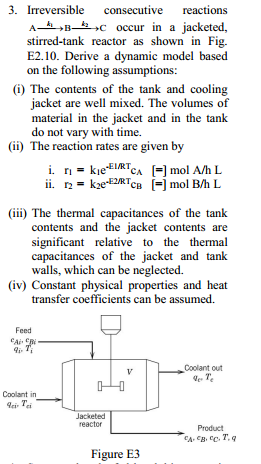
Transcribed Image Text:3. Irreversible consecutive reactions
A-Boccur in a jacketed,
stirred-tank reactor as shown in Fig.
E2.10. Derive a dynamic model based
on the following assumptions:
(i) The contents of the tank and cooling
material in the jacket and in the tank
do not vary with time.
(ii) The reaction rates are given by
iii) The thermal capacitances of the tank
contents and the jacket contents are
significant relative to the thermal
capacitances of the jacket and tank
walls, which can be neglected.
(iv) Constant physical properties and heat
transfer coefficients can be assumed.
Feed
Coolant out
4-T,
Coolant in
leir Tei
Jacketed
reactor
Product
Figure E3
Expert Solution
This question has been solved!
Explore an expertly crafted, step-by-step solution for a thorough understanding of key concepts.
This is a popular solution!
Trending now
This is a popular solution!
Step by step
Solved in 8 steps with 7 images

Recommended textbooks for you

Introduction to Chemical Engineering Thermodynami…
Chemical Engineering
ISBN:
9781259696527
Author:
J.M. Smith Termodinamica en ingenieria quimica, Hendrick C Van Ness, Michael Abbott, Mark Swihart
Publisher:
McGraw-Hill Education

Elementary Principles of Chemical Processes, Bind…
Chemical Engineering
ISBN:
9781118431221
Author:
Richard M. Felder, Ronald W. Rousseau, Lisa G. Bullard
Publisher:
WILEY
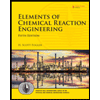
Elements of Chemical Reaction Engineering (5th Ed…
Chemical Engineering
ISBN:
9780133887518
Author:
H. Scott Fogler
Publisher:
Prentice Hall

Introduction to Chemical Engineering Thermodynami…
Chemical Engineering
ISBN:
9781259696527
Author:
J.M. Smith Termodinamica en ingenieria quimica, Hendrick C Van Ness, Michael Abbott, Mark Swihart
Publisher:
McGraw-Hill Education

Elementary Principles of Chemical Processes, Bind…
Chemical Engineering
ISBN:
9781118431221
Author:
Richard M. Felder, Ronald W. Rousseau, Lisa G. Bullard
Publisher:
WILEY

Elements of Chemical Reaction Engineering (5th Ed…
Chemical Engineering
ISBN:
9780133887518
Author:
H. Scott Fogler
Publisher:
Prentice Hall
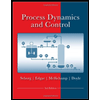
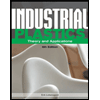
Industrial Plastics: Theory and Applications
Chemical Engineering
ISBN:
9781285061238
Author:
Lokensgard, Erik
Publisher:
Delmar Cengage Learning
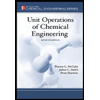
Unit Operations of Chemical Engineering
Chemical Engineering
ISBN:
9780072848236
Author:
Warren McCabe, Julian C. Smith, Peter Harriott
Publisher:
McGraw-Hill Companies, The